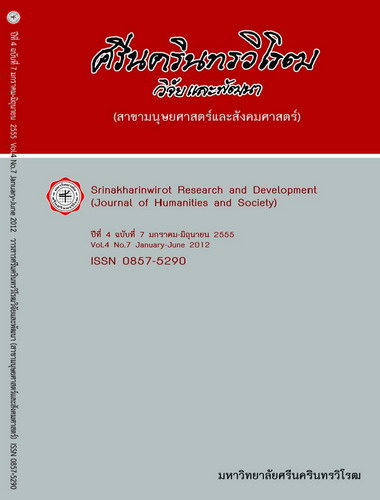การพัฒนารูปแบบการประเมินการฝึกอบรมข้าราชการทหารของกองทัพอากาศ: การประยุกต์ใช้การประเมินพหุแนวคิด (DEVELOPMENT OF AN EVALUATION MODEL OF ROYAL THAI AIR FORCE MILITARY OFFICERS’ TRAINING: AN APPLICATION OF MULTIPLE EVALUATION APPROACHES)
Keywords:
Training evaluation model, Multiple evaluation approaches, Military officers’ trainingAbstract
บทคัดย่อ การวิจัยครั้งนี้มีวัตถุประสงค์เพื่อพัฒนารูปแบบการประเมินการฝึกอบรมข้าราชการทหารของกองทัพอากาศ โดยประยุกต์ใช้การประเมินพหุแนวคิด ซึ่งมีวัตถุประสงค์เฉพาะ คือ 1) เพื่อกำหนดแนวคิดการประเมินการฝึกอบรม 2) เพื่อวิเคราะห์ และสังเคราะห์องค์ประกอบ และตัวบ่งชี้ในการประเมินการฝึกอบรม 3) เพื่อสร้างรูปแบบการประเมินการฝึกอบรม และ 4) เพื่อทดลองใช้และประเมินรูปแบบการประเมินการฝึกอบรมข้าราชการทหารของกองทัพอากาศที่พัฒนาขึ้น แหล่งข้อมูลในการวิจัย ได้แก่ เอกสารหลักสูตรการฝึกอบรม 78 ชุด เอกสารรายงานการฝึกอบรม 64 ชุด ผู้เกี่ยวข้องกับการฝึกอบรม จำนวน 279 คน ผู้ทรงคุณวุฒิด้านการประเมินการฝึกอบรมและการฝึกอบรม จำนวน 21 คน เครื่องมือที่ใช้ในการวิจัย ได้แก่ แบบวิเคราะห์เอกสาร แบบสัมภาษณ์ไม่มีโครงสร้าง แบบสอบถาม และแบบประเมินการฝึกอบรม วิเคราะห์ข้อมูลเชิงปริมาณโดยใช้ค่าความถี่ ร้อยละ ค่าเฉลี่ย และส่วนเบี่ยงเบนมาตรฐาน ส่วนข้อมูลเชิงคุณภาพใช้การวิเคราะห์เนื้อหา
ผลการวิจัยสรุปได้ดังนี้
1. แนวคิดการประเมินการฝึกอบรมของข้าราชการทหารของกองทัพอากาศอยู่บนพื้นฐานการประเมินพหุแนวคิด 6 กลุ่มแนวคิด ได้แก่ แนวคิดการประเมินอิงผลสัมฤทธิ์ แนวคิดการประเมินอิงเศรษฐศาสตร์ แนวคิดการประเมินอิงระบบ แนวคิดการประเมินอิงทฤษฎี แนวคิดการประเมินอิงผู้เกี่ยวข้อง และแนวคิดการประเมินอิงสภาพความเป็นจริง
2. องค์ประกอบและตัวบ่งชี้ในการประเมินการฝึกอบรม ประกอบด้วย 1) การประเมินก่อนการฝึกอบรม มี 4 องค์ประกอบ ครอบคลุม 5 ตัวบ่งชี้หลัก 67 ตัวบ่งชี้ย่อย 2) การประเมินระหว่างการฝึกอบรม มี 4 องค์ประกอบ ครอบคลุม 4 ตัวบ่งชี้หลัก 57 ตัวบ่งชี้ย่อย 3) การประเมินหลังการฝึกอบรม มี 7 องค์ประกอบ ครอบคลุม 12 ตัวบ่งชี้หลัก 59 ตัวบ่งชี้ย่อย
3. รูปแบบการประเมินการฝึกอบรมข้าราชการทหารของกองทัพอากาศ ประกอบด้วย 2 องค์ประกอบหลัก ได้แก่ ส่วนที่เป็นกรอบแนวคิดของรูปแบบและส่วนที่เป็นข้อความรู้ และแนวปฏิบัติเกี่ยวกับการประเมินการฝึกอบรม ประกอบด้วย นิยามของการประเมินการฝึกอบรม เป้าหมายของการประเมินการฝึกอบรม วัตถุประสงค์ของการประเมินการฝึกอบรม ประเภทของการประเมินการฝึกอบรม บทบาทของการประเมินการฝึกอบรม กระบวนการประเมินการฝึกอบรมและสิ่งที่มุ่งประเมิน
4. ผลการทดลองใช้และประเมินรูปแบบการประเมินการฝึกอบรมที่พัฒนาขึ้นพบว่า รูปแบบการประเมินนำไปทดลองใช้ได้ครบตามสถานการณ์ของการประเมินทั้งการประเมินก่อนการฝึกอบรม ระหว่างการฝึกอบรม และหลังการฝึกอบรม โดยผู้ทดลองใช้รูปแบบเห็นด้วยว่า รูปแบบการประเมินมีประโยชน์ต่อการประเมินการฝึกอบรมโดยให้องค์ความรู้ที่จำเป็น มีความเป็น ไปได้โดยนำไปปฏิบัติได้จริง มีความเหมาะสม โดยมุ้งเน้นประสิทธิผลในการประเมินการฝึกอบรม และ มีความถูกต้องโดยให้ข้อมูลอย่างชัดเจนและเพียงพอ
The purpose of this research was to develop a model of training evaluation for the Royal Thai Air Force military officers by applying the multiple evaluation approaches with the specific purposes as follows; 1) to analyze the context of evaluation; 2) to analyze and determine the concept of a training evaluation; 3) to develop the component, indicator and a model of training evaluation for the Royal Thai Air Force military officers and; 4) to try out and evaluate a developed evaluation model. Key informants for this research were 78 curriculum documents for training, 64 training reports, 279 training stakeholders and 21 experts of evaluation and training. Collecting data were document analysis, unstructured interview, questionnaire and training evaluation form. Quantitative analysis was done by using frequency, percentage, average and standard deviation. Qualitative analysis was done by using content analysis.
Research results are concluded as follows.
1. The Royal Thai Air Force military officers’ training concept was based on 6 multiple evaluation approaches (RESTAR-Multiple Evaluation Approaches):Results-based Evaluation Approach; Economic-based Evaluation Approach; System-based Evaluation Approach; Theory-based Evaluation Approach; Actor-based Evaluation Approach and Real-world-based Evaluation Approach.
2. Components and indicators of the training evaluation contain 1) pre-training-evaluation which was composed of 4 components including 5 main indicators and 67 sub-indicators 2) on-training-evaluation which consisted on 4 components including 4 main indicators and 57 sub-indicators 3) post- training-evaluation were made up with 7 components including 12 main indicators and 59 sub-indicators.
3. A model of training evaluation for the Royal Thai Air Force military officers has 2 main components: concept framework of training evaluation and basic knowledge and guideline of training evaluation covering definition, goal, objective, type, role, process and target of evaluation.
4. The try-out and evaluation on the model of training evaluation found that the training evaluation model could be used for all evaluated situations: pre-training evaluation, during training evaluation and post-training evaluation. Most users of training evaluation model agreed that 1) the developed training evaluation model was a useful model for training evaluation by providing necessary knowledge, 2) it was likely to use the training evaluation in reality, 3) the training evaluation model was suitable with a concentration on effectiveness of training evaluation; and 4) the training evaluation model was accurate in giving sufficient and distinct information.
Downloads
Downloads
Published
How to Cite
Issue
Section
License
Srinakharinwirot Research and Development Journal of Humanities and Social Sciences is licensed Under a Creative Commons Attribution-NonCommercial-NoDerivs 4.0 International (CC-BY-NC-ND 4.0) License, Unless Otherwise Stated. Please Read Journal Policies Page for More Information on Open Access, Copyright and Permissions.



